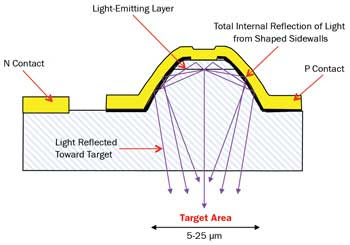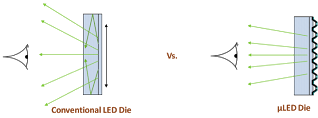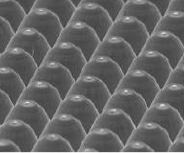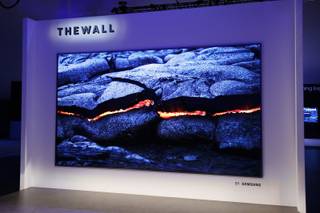micro-LED latest display technolgy:What is it? What are it's advantages and disadvantages and current trends
- Structure of LED panel displays
- LCD,LED,OLED and mLED
- Structure of a microLED
- Pros and Cons of micro-LED technology
- Current trend in micro-LED
MicroLED is the latest in he emerging display technologies .Starting from CRT, through LCD,LED ,OLED and mLED, display technology is evolving at higher speed. mLED displays consist of arrays of microscopic LEDs forming the individual pixel elements. It has got lot of advantages over other existing display technologies.
Micro LED was first realised by in the year 2000 by a research group run by Prof. Hongxing Jiang and Prof. Jingyu Lin of the Texas Tech University.
Let us recall the basic structure of LED display.
An LED display is a flat panel display, which uses an array of light-emitting diodes as pixels for a video/picture display.As you know an LED( light-emitting diode) is a p-n junction which emits light when electric current is passed through it.In an LED dispaly panel , these LEDs are shrunk down dramatically and arranged in red, green and blue clusters to create an individual pixel that can reproduce white light and various colors.
LED V/s LED back-lit LCD V/s OLED V/s micro-LED
LED displays are used in large displays like leaderboards,advertising pannels etcc. LED TVs and Smartphones displays are usually LCD with LED back-light. Usually consumers think that LED TVs have LED display. It is LED backlit LCD. But, OLED and micro-LED ae self illuminating.In an OLED(Organic Light Emitting Diode), a thin layer of organic material is placed between two conductors, which is then used to produce light when a current is applied.At least one of these electrodes is transparent.Properties of these organic material is analogous to semiconductors.
Micro-LED isn't a new display technology, this technology is a solution to the problem faced by panel manufacturers.It helped them to mass transfer and bond million of tiny LEDs in a minimum area.Individual micro-LEDs usually ranges from 1 to 10 μm, and are transferred in large volumes onto the display substrate.
Structure of a single µLED
 |
| microLED light extracting structure(image courtesy infiniled ) |
 |
| conventional LED Die Vs µLED |
 |
| Scanning electron microscope (SEM) image of an array of shaped μLEDs |
Advantages of micro-LED over TFT-LCD and OLED displays
-High contrast ratio. In backlit TFT-LCD panels complete black is not possible.Black is represented by dark grey only. This is because back-light cannot be switched off it completely. But microLED is self illuminating. So pure black can be obtained by switching off the individual micro-LED. This is one of the main advantage of micro-LED displays.
-Improved brightness to power (lux/W) efficiency, meaning that the same panel brightness can be achieved for lower power.Power consumption can be 90 percent lower than LCD and up to 50 percent lower than OLED
-Micro-LED displays will also offer a longer lifespan than current OLED panels. Lifespan of the organic materials used to make the blue OLED is limited.
-Higer resolution in compact form and higher PPI. This makes them perfect for smartphones and VR displays
-High response times in the ns (microsecond) range.This feature make them suitable for VR headsets.
-Suitable for flexible displays.It's tiny structure can be deposited on a flexible substrate to form flexible display panels. Unlike TFT-LCD and OLED , damage would be minimum on bending or rolling.
-Sony launched its 55-inch “Crystal LED Display” in 2012, a new micro LED display technology utilizing Full HD Resolution. The display uses about 6.22 million micro LEDs
-Samsung unveiled its first MicroLED TV at CES 2018, the 146-inch "The Wall" 4K TV.
-Improved brightness to power (lux/W) efficiency, meaning that the same panel brightness can be achieved for lower power.Power consumption can be 90 percent lower than LCD and up to 50 percent lower than OLED
-Micro-LED displays will also offer a longer lifespan than current OLED panels. Lifespan of the organic materials used to make the blue OLED is limited.
-Higer resolution in compact form and higher PPI. This makes them perfect for smartphones and VR displays
-High response times in the ns (microsecond) range.This feature make them suitable for VR headsets.
-Suitable for flexible displays.It's tiny structure can be deposited on a flexible substrate to form flexible display panels. Unlike TFT-LCD and OLED , damage would be minimum on bending or rolling.
Disadvantages of micro-LED pannels
-Micro-LED panels are expected to be considerably more expensive, possibly three to four times higher than current LCD and OLED panels.This will fall in time, but it will slow down the investments.Current trends in micro-LED panels
2010 onwards , manufacturers are aggressively behind micro-LED display technology R&D. Manufacturers leading in micro-LED patent applications include Apple affiliated Luxvue, Mikro Mesa, Sony, Leti and others.-Sony launched its 55-inch “Crystal LED Display” in 2012, a new micro LED display technology utilizing Full HD Resolution. The display uses about 6.22 million micro LEDs
-Samsung unveiled its first MicroLED TV at CES 2018, the 146-inch "The Wall" 4K TV.
Commercial launch of large microLED panels would take some time since manufactures have to limit the cost within a limit to make it suitable for consumer electronic devices.
-Mass transfer is a critical technology for Micro LED manufacturing, transferring Micro LED to a target backplane quickly and accurately will be one of the topics that manufacturers need to work on the most.
-Mass transfer is a critical technology for Micro LED manufacturing, transferring Micro LED to a target backplane quickly and accurately will be one of the topics that manufacturers need to work on the most.

No comments:
Write comments